WORKLOAD ANALYSIS TO DETERMINE THE OPTIMAL NUMBER OF EMPLOYEES AFTER THE HOLDING-SUBHOLDING TRANSFORMATION IN THE BUSINESS SUPPORT DIVISION OF PT PLN NUSANTARA POWER, BELAWAN GENERATION UNIT
Main Article Content
April Yanto Wilsam Pasaribu
Prihatin Lumbanraja
Iskandirini
The organizational transformation through the Holding-Subholding program within PT PLN (Persero) has brought significant changes to the organizational structure and workload distribution, particularly in the Business Support Division of PT PLN Nusantara Power, Belawan Generation Unit. These changes are evident from the increased number of overtime hours due to the reassignment of several employees from the Business Support Division and the addition of new tasks. This study aims to identify the optimal number of employees by analyzing the current workload in the Business Support Division following the implementation of the Holding-Subholding program. The work time analysis was conducted using the Work Sampling method, and the employee requirements analysis was performed using the Full Time Equivalent (FTE) method, based on the guideline KEP/75/M.PAN/7/2004. The results of the study indicate that the effective working days in a year amount to 278 days, with an effective working time of 1,668 hours for a five-day workweek. Based on work sampling, the percentage of productive activities was 79.01%, non-productive activities 3.51%, and personal activities 17.47%, with a 20% allowance. The FTE workload measurement results show that in the Business Support Division, one staff position falls under the inload category, two positions under underload, and five positions under overload. The calculation also reveals a discrepancy between the actual number of employees and the ideal staffing needs, including shortages of 2 staff members in the HR Officer position, 1 in the Accounting Officer position, and 1 in the Procurement Officer position. However, there is also an excess of 1 staff member in the Finance Officer position.
Ariyanti, S., & Yasmin, Z. (2018). Analisis Beban Kerja Pada Maintenance Bd-Check Dengan Metode Full Time Equivalent. Jurnal Ilmiah Teknik Industri.
Brannick, M. T., Levine, E. L., & Morgeson, F. P. (2019). Job and Work Analysis: Methods, Research, and Applications for Human Resource Management. SAGE Publications.
Dessler, G. (2020). Human Resource Management. New Jersey: Pearson.
Handoko, T. H. (2019). Manajemen Sumber Daya Manusia. Yogyakarta: BPFE.
Hasibuan, Malayu S.P. 2005. Manajemen Sumber Daya Manusia. Edisi Cetakan ketujuh. Jakarta: PT. Bumi Aksara.
Hidayah, N. (2022). Pengaruh Deskripsi Pekerjaan terhadap Kepuasan Kerja Karyawan. Jurnal Manajemen Sumber Daya Manusia
Irawati, Rusda dan Carollina, Dini Arimbi. 2017. Analisis Pengaruh Beban Kerja terhadap Kinerja Karyawan Operator pada PT Giken Precision Indonesia. Jurnal Inovasi dan Bisnis.
Kawiana,I Gede Putu .(2020) . Manajemen Sumber Daya Manusia “MSDM” Perusahaan. Denpasar: Unhi Press
Ladjin, Litriani, Sahamony, Kusumaningrum, Maulina, Siregar, Hubbansyah, Solikin, Silitonga, Soeyatno, Asyari, Sinaga, A. (2022). Manajemen Sumber Daya Manusia “Perspektif Pengembangan dan Perencanaan” . Bandung: CV. Widina Medina Utama .
Mahawati, Eni, dkk. (2021). Analisis Beban Kerja dan Produktivitas Kerja. Semarang: Yayasan Kita Menulis.
Mentri Pendayagunaan aparatur negara (2004). Keputusan mentri pendayagunaan aparatur negara no. 75 tahun 2004. Keputusan Mentri Pendayagunaan Aparatur Negara No. 75 Tahun 2004.
Rahman, M. & Setiawan, H. (2020). Pengaruh Beban Kerja terhadap Kepuasan Kerja Karyawan di Sektor Industri. Jurnal Manajemen.
Rino, A. (2020) Beban Kerja dan Stres Kerja. Pasuruan: CV.Penerbit Qiara Media.
Rivai, H. V. dan E. J. Sagala. 2009. Manajemen Sumber Daya Manusia untuk Perusahaan dari Teori ke Praktik. Jakarta: Rajawali Pers.
Sari, R. & Rahardjo, B. (2020). Pengaruh Beban Kerja terhadap Kepuasan Kerja Karyawan. Jurnal Manajemen Sumber Daya Manusia.
Sari, L. (2022). Dampak Restrukturisasi terhadap Beban Kerja dan Kebutuhan Karyawan. Jurnal Manajemen Perusahaan.
Simanjuntak, M. (2020). Pengukuran Kebutuhan Karyawan dalam Organisasi. Jurnal Manajemen.
Soleman, Aminah (2011). Analisis Beban Kerja Ditinjau Dari Faktor Usia Dengan Pendekatan Recommended Wight Limit, Universitas Pattimura, Ambon
Sugiyono. (2019). Metode Penelitian Kuantitatif, Kualitatif, dan R&D. Bandung: Alfabeta
Surya, D. (2021). Pelatihan dan Pengembangan Karyawan: Implikasi terhadap Kinerja. Jurnal Pendidikan dan Pelatihan.
Tjiptono, F. (2020). Teori Sistem dalam Manajemen. Yogyakarta: Andi.
Wibowo, A. (2021). Efisiensi Kerja Karyawan dan Pengaruhnya terhadap Produktivitas. Jurnal Ekonomi dan Bisnis.

























